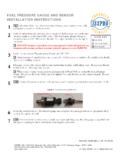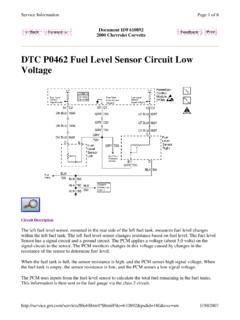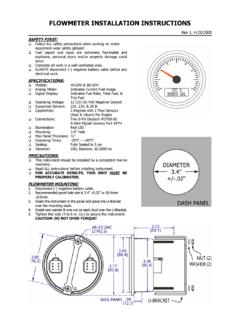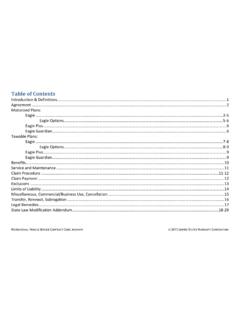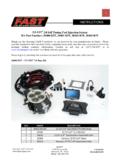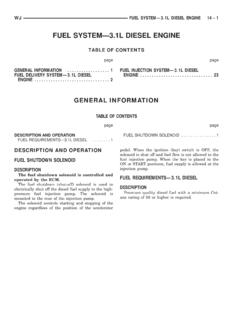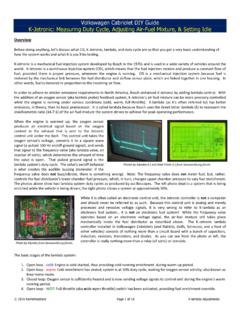Transcription of www.zenithfuelsystems.com
1 ! " ! #$ % % % & ' ( ))*+ CONTENTS SECTION PROGRAM PURPOSE and OBJECTIVES SECTION PHYSICAL PROPERTIES of GASOLINE and PROPANE SECTION SAFETY PROCEDURES SECTION DEFINITION of TERMS SECTION SYSTEM OPERATION SECTION MAINTENANCE PROCEDURES SECTION SYSTEM OPERATING SPECIFICATIONS SECTION WIRING DIAGRAMS SECTION DIAGNOSTIC PROCEDURES SECTION SERVICE PARTS AIR QUALITY: According to the Environmental Protection Agency (EPA), more than 50% of Americans are breathing unhealthy air, yet after more than 20 years of air quality standards, excessive pollution still exists in many areas of the country. In 1998 California Air Resources Board (CARB) proposed new emission standards for industrial engines commencing with model year 2001. The EPA has also indicated that it will intro-duce new standards for the whole nation beginning model year 2004. Zenith Fuel Systems, Inc. has been manufacturing high quality gasoline and LPG fuel systems for industrial, military, agricultural and aircraft engines sine 1911.
2 It is with this rich history that in 1993 Zenith foresaw that the need would arise for a more ac-curate and better performing fuel system and commenced the development of a fuel injection and engine governing system specifically for industrial engines. PERFORMANCE: Currently, the proposed emission regulations, commencing in 2004, not only call for low exhaust emission levels but also re-quire that these levels be maintained for 5000 engine operating hours. Zenith Electronic Engine Management Systems (ZEEMS) has been designed to leap frog the poor performing electronic band aids used on carburetors by the automotive industry in the early days of automotive emission regulations and provide a system that will meet the future requirements of its customers today. NOTES The purpose of this section is not to give a lot of meaningless data, but rather aid in the quick diagnosis of problems. It has been the experience of many technicians that they will diagnose the fuel or the fuel system as the cause of a machine failure, only to discover after much unsuccessful time and effort, that the failure lay in the electrical or mechanical systems and not the gasoline or propane system.
3 An understanding of the physical properties of propane and how they compare to gasoline will greatly assist the technician in making a quick and accurate diagnosis of a problem. NOTES ! "! # ! $ %& "%'((( ('&)( ""*'((( ) & + !( $ **( " *, - . ), "* . / " & ! %+ $ "(* "%'% ( "')+( !+'+(( * " + - ** &.,- % +, "+ + / " 012 345 67 89:;< 45: :==:5 367>93=65< 68 :;:3=5034; :7:51 29< ?56?47: >:@47> < @65: :;:3=5034; :7:51 =6 0170=: =2: 89:; 405 @0A=95: 6B 345 67 89:;< 24C: ;6B:5 :A249<= :@0<<067< 0=2 3=47: 54=071 :071 4 @:4<95: 68 4 89:; < 5:<0<=473: =6 D763D' ?56?47: 347 <=47> 2012:5 36@?5:<<067 ?5:<<95:< 47> @65: 4>C473:> 0170=067 =0@071 =247 14<6;07: 012 2 >561:7 =6 345 67 54=06 89:;< ?56->93: @65: 2:4= :7:51 ?:5 ?697>' B2:5: 4< 2012 345 67 =6 2 >561:7 54=06 89:;< 24C: @65: 2:4= :7:51 ?:5 14;;67 9:; @0;:41: 67 ?56?47: B0;; : ;:<< =247 =2: @0;:41: 67 14<6;07: ;=26912 4 ?56?47: =47D 0< 2:4C0:5 =247 0=< 14<6;07: 3697=:5?45=' 89;; ;4>:7' =6=4; B:012=< 45: <0@0;45 6=2 89:; C4?)))))))))))
4 65< 45: 2:4C0:5 =247 405 6C: $** ?56?47: :36@:< 4 C4?65 7 6?:7 405 56?47:' 97;0D: 14<6;07:' 0< <=65:> 97>:5 ?5:<<95: 2: ?5:<<95: C450:< B0=2 =:@? = &+ >:1 ' =47D ?5:<<95: 0< +! E 4= %+ >:1 =47D ?5:<<95: B0;; : ")( NOTES Safety in garaging and repairing machinery is an important con-sideration. Follow the rules and procedures that apply to the machine local when repairing both gasoline and propane fuel systems. Propane and gasoline have excellent safety records, however, in-jury can occur when mishandled. As shown in section 2, the physical properties of propane are somewhat different than gasoline, thus requiring different handling and safety procedures. NFPA 58 chapter 8 : 6 lays out the basic procedures for garag-ing and repairing propane powered vehicles. Vehicles with LP-Gas fuel systems shall be permitted to be serv-iced or stored inside garages, provided that : (a) The fuel system is leak-free and the container is not filled be-yond the limits specified.
5 (b) The container shutoff valve is closed when vehicles or en-gines are under repair except when engine is operated. (c) The vehicle is not parked near sources of heat, open flames, or similar sources of ignition, or near inadequately ventilated pits. Carbon Monoxide. Carbon monoxide (CO) is a colorless, taste-less, and odorless gas and gives no warning of its presence. Those exposed to it do not realize it is present until symptoms begin to develop. The exhaust emissions from internal combustion engines can in-crease through the lack of maintenance. This can cause the car-bon monoxide inside a building to climb above the OSHA maxi-mum limit of 50 ppm during an eight-hour period. Examples 1 and 2 below are indications of the important role the current air/fuel mixture settings play in indoor air quality. Example 1: A machine with 150 engine running at 2,000 rpm full load will consume approximately 75 of air in 1 minute or 4,500 per hour. If the exhaust CO reading is 4 percent, the machine would produce 180 of CO in one hour.
6 A warehouse 100 x 100 x 20 contains 200,000 of air. OSHA standards allow a maximum of 50 ppm (parts per million) of CO in the fac-tory s air, (which is of 200,000 = 10 of CO), it will take minutes to contaminate the warehouse above OSHA standards. Example 2: Same initial information as in Example 1, but the new exhaust reading is CO. The machine will now produce 9 of CO in one hour and it will take 1 hr/6 min. to reach allowable standards for CO. These examples did not allow for replacement air entering the building. Also, it is highly unlikely that a machine would operate in a full-power condition for the lengths of time noted in the examples. Nevertheless, the examples do illustrate how important the mixture setting is to air quality conditions. LEVELS OF CARBON MONOXIDE EXPOSURE EFFECTS OF CARBON MONOXIDE EXPOSURE 9 PPM ( ) The maximum allowable concentration for short-term exposure in living areas, according to the American 50 PPM ( ) The maximum allowable US OSHA concentration for continuous exposure in any eight-hour period, according to federal law 200 PPM ( ) Slight headaches, tiredness, dizziness, and nausea after 2-3 hours 460 PPM ( ) Frontal headache within 1-2 hours.
7 Life threaten-ing after three hours. The maximum allowable concentration according to the US EPA and AGA 800 PPM ( ) Dizziness, nausea, and convulsions within 45 min-utes. Death within 1 hour BAT Battery Voltage CAT Catalyst or Catalytic converter CKP Crankshaft Position CKPS Crankshaft Position sensor ECU Electronic Control Unit ECT Engine Coolant Temperature ECTS Engine Coolant Temperature sensor EGO Exhaust Gas Oxygen EGOS Exhaust Gas Oxygen sensor ESC Electronic Spark Control ESCM Electronic Spark Control Module IAT Intake Air Temperature IATS Intake Air Temperature sensor IMAP Intake Manifold Absolute Pressure IMAPS Intake Manifold Absolute Pressure sensor LPG Liquid Petroleum Gas (propane) NFPA National Fire Protection Association SFC System Fault Code SFL System Fault Light Vsw Switched battery voltage ZEEMS Zenith Electronic Engine Management System NOTES NOTES The spark-ignited engine (Otto Cycle)
8 Is a constant air-fuel ratio engine, and although the volume of air inside the cylinders re-mains constant, the density of air ( MAP or Vacuum) varies ac-cording to the throttle position. Absolute Pressure: Absolute Pressure is a pressure using a scale with zero starting at zero atmospheric pressure (PSIA) Gauge Pressure: Gauge Pressure is a pressure using a scale with zero starting at atmospheric pressure (PSIG) Zero PSIG = PSIA hg. The Zenith Electronic Engine Management System (ZEEMS) con-trols both fuel delivery and the governor/throttle with an inte-grated throttle body and electronic control unit design. Each control system is described separately, but in actual operation, control of fuel and throttle happen simultaneously. NOTES Fuel System: Review of a gasoline carburetor system will aid in understanding the ZEEMS fuel system operation. Carburetors, mechanical fuel injection systems and electronic fuel injection systems all perform the same basic functions; however, the methods incorporated to perform these functions differ.
9 The fundamental purpose of any fuel system is to measure the incoming air and mix the appropri-ate amount of fuel with it under all engine operating conditions. The carburetor performs three main functions. These functions are: a. To deliver a mixture of gas and air in a ratio that suits each condition of engine operation. b. To atomize the gasoline as it enters the intake manifold. c. To control the volume of air / fuel delivered in response to throttle position and engine operation condition. In reality, each engine operating condition requires a circuit or mechanism to be designed into and attached to the gasoline car-buretor to ensure that the engine will operate without hesitation or flat-spot and give maximum power with the optimum fuel economy within the levels of emissions for that model and year of engine design. The ZEEMS fuel injection system is based on the speed-density concept. The ECU uses engine RPM, IMAP, IAT and ECT to calculate the fuel required for a specific engine operat-ing condition.
10 By using RPM, IMAP, IAT and ECT to calculate in-take manifold air density, the ECU calculates the correct fuel re- NOTES In the near future when exhaust catalysts are needed to make the required emission standards, an exhaust gas oxygen sensor (EGOS) will be included to make further corrections to fuel re-quirements to enhance exhaust catalyst efficiency. Once the required fuel delivery is calculated, fuel under pressure from the fuel pump is injected via the fuel injector into the air stream above the throttle plate. The fuel injector acts as a simple on/off solenoid. The volume of fuel flow is determined by varying the length of time the injector is held open by the ECU. This is known as pulse width modula-tion (PWM) and is measured in milliseconds. The injector is pulsed each time a spark plug fires. Each time a plug fires and that cylinder is in the power stroke, another cylinder is in the in-take stroke. Between each spark plug firing, the ECU calculates the fuel required for the next engine event based on the informa-tion provided to the ECU.

